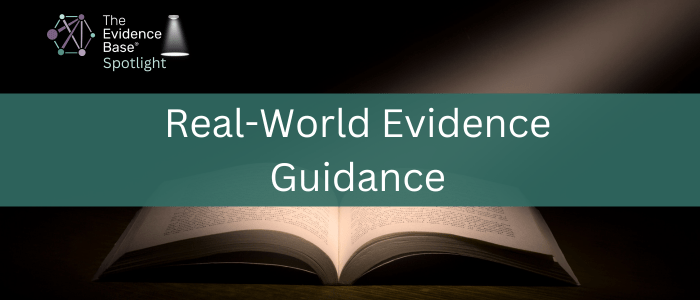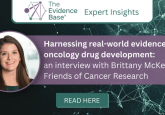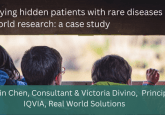GetReal Conference 2024: insights from Day 1

Following the inaugural event in 2023, the GetReal Institute Conference 2024 is taking place May 14–15, 2024 in Utrecht, The Netherlands, focusing on the theme ‘A Growing Convergence: RWE for Regulatory and HTA Decision-Making’. As media partner for the conference, over the next 2 days The Evidence Base team is covering the event to provide insights from the presentations to ensure our audience stays informed about the latest developments and insights in the field.
Click below to read the coverage of Day 2
Over the next few weeks we’ll also be taking a closer look at the discussions from the 2 days, providing ‘deep dives’ into the sessions. Register on The Evidence Base to receive regular updates and be notified when coverage is published on the site.
Opening remarks
Shahid Hanif (Managing Director, GetReal Institute) welcomed the attendees to the second GetReal Conference. Hanif highlighted the institute’s mission to facilitate the adoption of real-world evidence (RWE) for regulatory and clinical decision-making, before discussing the agenda for the next 2 days. On Day 1, speakers will reflect on developments since last year’s inaugural GetReal Conference; discuss regulatory updates from international bodies including the EMA, FDA, MHRA, and others; debate on the progress towards adopting RWE; and describe experiences from HTA organizations and industry. Day 2 will take a deep dive into methods used in various projects and include sessions aligning regulatory and HTA perspectives on RWE; finishing with a town hall-style open discussion.
Hanif concluded by expressing gratitude to the GetReal Institute Executive Board and The Evidence Base, and thanked sponsor, Flatiron Forum. He encouraged audience interaction throughout the conference, before introducing the panelists for the first session.
Session 1 – ‘Throw back’ to last year, how is regulatory and HTA converging?
The conference’s first session took the form of a Fireside Chat featuring Irene Nunes (Genmab, USA) and Per-Olof Thuresson (Roche, Switzerland), moderated by Shahid Hanif. They began by discussing the concept of ‘convergence’ in the context of regulatory decision-making and health technology assessment (HTA). Nunes emphasized the need for substantial evidence for regulatory decisions and data demonstrating benefit over standard care for HTA, stressing the importance of data quality and confidence for decision-making. Thuresson noted the distinct purposes of regulatory and HTA processes, highlighting that while they may not merge, each could adopt practices from the other to some extent.
Throughout the session, the speakers emphasized the importance of standardization in collecting and analyzing real-world data (RWD), citing the emergence of numerous global guidelines in recent years.
Learn more about RWE guidance in our spotlight here >>>
The speakers discussed challenges related to data access and privacy, particularly the fragmentation of data in Europe and the US, and the need for interoperability among electronic medical records (EMRs). Nunes mentioned the FDA’s Project 5 in 5 as an example of RWD utilization, focusing on identifying clinically relevant questions for pragmatic clinical trials in oncology over a 5-year period.
Priorities for optimizing RWD use were outlined, including improving causal reasoning, enhancing data collection at the point of care, operationalizing study designs, and enhancing data transportability for comparability. Nunes emphasized the importance of understanding current RWD usage by regulatory bodies and how they are addressing issues such as missing data.
The session concluded with an audience Q&A, highlighting the necessity of bringing stakeholders together – including patients, regulators, sponsors, physicians, and academics – in neutral forums like those organized by the GetReal Institute to foster open dialogue and address limitations in RWD utilization.
Session 2 – What does good look like? Progress in regulatory decision-making with RWE
Moderator Álmath Spooner (AbbVie, Ireland) introduced the panel, which included Patrice Verpillat (European Medicines Agency’s [EMA], The Netherlands), Donna Rivera (FDA, USA) , Alison Cave (Medicines and Healthcare products Regulatory Agency [MHRA], UK) and Katrien Oude Rengerink (College ter Beoordeling van Geneesmiddelen–Medicines Evaluation Board [CBG-MEB], The Netherlands). Verpillat opened the presentations by providing the EMA perspective, explaining their vision that, “by 2025 the use of RWE will have been enabled and its value will have been established across the spectrum of regulatory use cases”. He highlighted the developments to date with DARWIN EU and the EMA’s recent report reflecting on their experience gained in conducting RWD and RWE studies. The report, which will be updated within the next few months to include their experience up to February 2024, made several recommendations that the EMA is working to address. Verpillat noted the EMA is also collaborating on an international level, such as towards the forthcoming ICH M14 guideline on, “General principles on plan, design, and analysis of pharmacoepidemiological studies that utilize RWD for safety assessment of medicines”.
Rivera provided the audience with an update on advancements within the FDA Oncology RWE Program, detailing how the agency utilizes RWD for regulatory purposes and explaining the criteria the agency considers to define what constitutes ‘good’ in this context. This was illustrated via a recent a case study in which RWE was considered for regulatory approval in the context of a rare oncology indication. Rivera discussed some of the challenges as well as opportunities; for instance, through collaboration with the regulatory science team. Rivera shared some of the FDA’s new RWE initiatives, referring the audience to the new FDA and NIH co-developed draft glossary for consistent clinical and RWE research terminology, as well as Project 5 in 5: an initiative focused on modernizing clinical trials by crowdsourcing five clinically relevant questions that pragmatic clinical trials will address over the next 5 years, as called out in Session 1 by Irene Nunes.
Cave, providing the MHRA perspective, reflected on a presentation she gave in 2018 and the progress (or lack of) that has been made since. Whilst progress has been made on data sources, data characterization and quality remain a challenge, with regulatory acceptability of RWE still dependent on the use case. Cave reflected on the experience gained in using RWE to inform policy and healthcare decisions during the COVID-19 pandemic. RWD can also be used to bridge the gap in clinical trials to provide greater insights into demographic subgroups that might be underrepresented or excluded from clinical trials. Despite the progress made over the past few years, Cave acknowledged that many questions still remain.
Addressing the question of ‘what does good look like’, Oude Rengerink used the analogy of a perfect holiday; noting how this concept varies among individuals according to their specific requirements and expectations. Coming from the regulatory perspective, RWD is typically assessed for effectiveness and efficacy, and the evidence needs to add to the total body of evidence to address specific research questions. Oude Rengerink discussed the need for transparency and rigor in observational research, highlighting the estimand and target trial frameworks. She also touched on the need for fit-for-purpose data sources, noting the need to have insights into the data collection structure and missing data. Echoing the rest of the panel, Oude Rengerink emphasized the obvious – starting with a research question and aligning the analysis design and methods to the question.
Session 3 – The Big Debate: This house believes we are making good progress towards adopting RWE as part of the HTA Regulation
The next session took the form of a lively Oxford-style debate, moderated by Shahid Hanif, discussing the motion, ‘This house believes we are making good progress towards adopting RWE as part of the HTA regulation.” Inka Heikkinen (MSD, Denmark) and Anke van Engen (IQVIA, The Netherlands) spoke against the motion, while Iñaki Gutiérrez-Ibarluzea (BIOEF, Spain) and Juan Carlos Rejón-Parrilla (AETS, Spain) spoke for the motion. To kick off the debate, Hanif first invited the audience to vote on the motion themselves, with the vote to be re-taken after the speakers had provided their arguments. Although not shared with the speakers, the audience began in a fairly equally divided position, with 47% in favor of the motion, and 53% against.
Speaking first for the opposition, Heikkinen called on the text of the HTA regulation itself, which states that we, “should however not per se exclude observational studies, including those based on RWD.” Although the regulation does mention RWD (with the qualifier per se), Heikkinen stated that randomized controlled trials are clearly favored, and as such the position for RWE has not been advanced.
Following a short rebuttal of the opening statements against the motion, Gutiérrez-Ibarluzea countered these arguments, asserting that decision-making processes necessitate the use of RWE, highlighting its role in revealing unintended consequences unattainable through trials. Rejón-Parrilla continued the argument by providing some specific examples of progress in RWE use, including the European Health Data Space, European HTA guidances, and at the country-level, use by RedETS in Spain, HAS in France, and the NICE RWE Framework in the UK.
These statements were rebutted by van Engen, before moving into questions amongst the speakers and then with the audience. Topics discussed included the slow progress of RWE integration into HTA regulation; variation in country-level approaches to evidence evaluation; other types of health technology beyond drugs; opportunities for cross-country collaborations; and data quality and interoperability, amongst other areas.
At the end of the session, the audience was again asked to vote, and interestingly, a shift was seen towards the argument against the motion – with 66% of the audience voting that way. Further debate on the practicalities of RWE use in HTA regulation will clearly be an important focus of future discussions.
Session 4 – Deploying methods in HTA: the experiences of HTA bodies using RWE methods
Blythe Adamson (Flatiron, USA), also chair of the GetReal Institute Board, welcomed the panelists to the session and invited Anja Schiel (NOMA, Norway) to the stage. Schiel set the scene by detailing the differing evidence requirements of regulators and HTA bodies in decision-making, explaining how the latter want and can use RWE. Schiel detailed how regulators have an ‘easy job’ in being able to utilize global evidence, whilst HTA bodies must use more relevant, local evidence to support internal validity and context. Schiel closed by outlining the various roles of RWD/E in evidence generation to support internal validity, how it is used for relative effectiveness, and is needed for external validity.
Next, Farah Hussein (Canada’s Drug Agency, Canada) provided the Canadian HTA perspective, explaining how comparative effectiveness RWE can be used to address core questions during the HTA process: how the health technology compares with existing treatment options and whether it is of good long-term value. Hussain referred to the recently published guidance for reporting RWE, intended for stakeholders to enhance the quality of RWE, incorporate best practices and principles, and align with similar documents from other organizations. She explored the methods the agency uses to appraise RWE, including a pilot of the ISPE tool. The agency is dedicated to examining how RWE can provide a more comprehensive understanding of the risk, benefit, economic value, and other contextual considerations associated with interventions. Hussain emphasized the importance of early engagement and clearly explained the rationale for using RWE. Key principles of RWE include ensuring data quality and suitability, maintaining transparency, and employing analytical methods to address bias.
Stephen Duffield (NICE, UK) noted the shifting UK data landscape providing opportunities for NICE to generate RWE. Noting the ‘astounding increase’ in use of RWE by NICE over the past few years, a report noted almost 82% of HTA records included RWE in 2021. Duffield explored the influence of RWE in NICE, explaining that the agency uses RWE in numerous research questions, including estimating comparative treatment effects in around 26% of appraisals. Duffield outlined the NICE RWE framework and shared a RWD use case that triangulated evidence from a randomized controlled trial, RWE and in vitro data to support a committee decisions for COVID-19 treatments. Despite numerous tools and methods being included within the framework to aid transparency, they are not being used to their full potential within NICE submissions. Duffield highlighted the evolving nature of the NICE RWE Framework, initially published in 2022, emphasizing its continuous updates to incorporate advancements such as the HARPER tool for protocol design and data transportability. Additionally, the framework explores novel methodologies, including quantitative bias analysis, through pilot studies. Duffield concluded by underscoring the unprecedented importance of robust and transparent methods for RWE.
Closing remarks
At the end of Day 1, Conference Chair Shahid Hanif extended his gratitude to all participants, with a special acknowledgment to the speakers for generously sharing their insights. Following the final session, attendees engaged in lively discussions and debates over refreshments, paving the way for an enriching Day 2.







